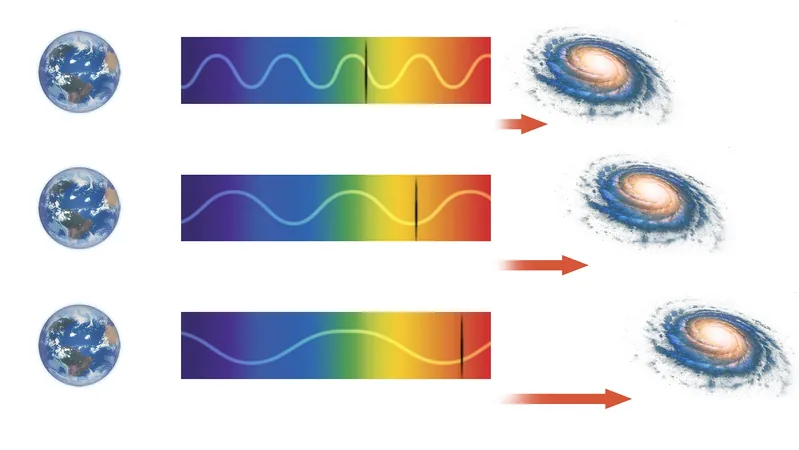
The Intriguing Mystery of Quantized Redshift: Is the Big Bang Theory on Shaky Ground?
2024-09-23
Author: Jia
In the realm of cosmology, a Doppler shift refers to the change in the frequency of light or sound produced by an object moving relative to an observer. Edwin Hubble's groundbreaking findings in 1929 revealed that galaxies are predominantly moving away from Earth, leading to the formulation of Hubble's Law and suggesting a vast, expanding universe.
This "redshift," which occurs when light waves from receding objects stretch toward the red end of the spectrum, has been a crucial indicator of distance in standard cosmology. But recent discoveries have started to challenge conventional wisdom—enter quantized redshift.
What Is Quantized Redshift?
Unlike traditional notions of cosmic expansion, some scientists argue that redshifts display periodicity, clustering around specific values instead of showing a smooth distribution. This intriguing behavior points to a possibility that distant galaxies and quasars may not just be mere indicators of distance but could be arranged in a quantized fashion, suggesting an unknown mechanism that operates independently of cosmic expansion.
Prominent astronomers such as William G. Tifft have observed regular patterns in the redshifts of galaxies, which has led some, including Halton Arp and Geoffrey Burbidge, to propose that certain discrepancies in quasar redshifts may stem from intrinsic properties related to their evolutionary processes rather than their distance from Earth.
Anomalies and Observations: The Case of Quasars and Galaxies
Research dating as far back as 1966 uncovers more anomalies. Notably, both Fred Hoyle and Jayant Narlikar identified instances where quasars and their associated galaxies demonstrated different redshifts—raising questions about the nature of their physical association. A striking example involves a quasar located nearly within the galaxy NGC 7319 but exhibiting a vastly different redshift value.
Even more perplexing are the findings from the James Webb Space Telescope (JWST), which uncovered the enigmatic GNz7q, a dusty starburst galaxy. Observations suggest that a luminous quasar is emerging from it, creating inconsistencies with current theories about the formation of black holes shortly after the Big Bang.
Moreover, another high-redshift galaxy, GN-z11, estimated to be just 70 million years old, challenges our understanding of galaxy formation by appearing at odds with the timeline and structure presumed by standard cosmological models.
Breaking the Paradigm: What Does This Mean?
The implications of these observations are profound. They challenge the fundamental cosmological principle that asserts the universe's homogeneity and isotropy on a large scale. Additionally, they contradict predictions regarding high-redshift objects and the expected evolutionary pathways for galaxies and quasars.
Two leading theories attempt to explain the quantized redshift phenomenon. The Hoyle-Narlikar variable mass hypothesis posits that quasars are ejected from the centers of galaxies with lower mass initially and gather mass over time, reducing their redshift. Another theory, dynamic multiple scattering, suggests that redshift effects could arise from the medium's characteristics rather than motion.
In summary, the study of quantized redshift may put the Big Bang theory under scrutiny, positioning alternative cosmological models as appealing contenders. With ongoing advancements in observational technology, like JWST, the full scope of these discoveries promises to reshape our understanding of the universe.
The search for evidence continues, as the quest to understand the mechanisms behind redshift not only casts doubt on longstanding theories but also opens doors to exciting new possibilities in cosmology. Stay tuned as this astronomical puzzle unfolds, challenging our deepest beliefs about the universe's inception and evolution!



 Brasil (PT)
Brasil (PT)
 Canada (EN)
Canada (EN)
 Chile (ES)
Chile (ES)
 Česko (CS)
Česko (CS)
 대한민국 (KO)
대한민국 (KO)
 España (ES)
España (ES)
 France (FR)
France (FR)
 Hong Kong (EN)
Hong Kong (EN)
 Italia (IT)
Italia (IT)
 日本 (JA)
日本 (JA)
 Magyarország (HU)
Magyarország (HU)
 Norge (NO)
Norge (NO)
 Polska (PL)
Polska (PL)
 Schweiz (DE)
Schweiz (DE)
 Singapore (EN)
Singapore (EN)
 Sverige (SV)
Sverige (SV)
 Suomi (FI)
Suomi (FI)
 Türkiye (TR)
Türkiye (TR)
 الإمارات العربية المتحدة (AR)
الإمارات العربية المتحدة (AR)